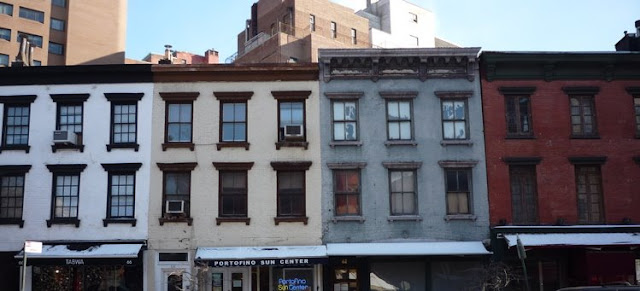The Light in Hopper: The Years on Washington Square North
 Edward Hopper (July 22, 1882 – May 15, 1967) lived at 3 Washington Square North, in what is commonly called "The Row," in Greenwich Village from 1913 until the day he died in 1967. He was almost 85, and presumably, he saw many changes during the course of five decades as he looked out his studio windows onto Washington Square. He moved into the Village in the year of the Armory Show (1913), the New York world of the Ashcan artists, the bohemians, the theater of Eugene O'Neill and the Provincetown Playhouse, Mabel Dodge's salons, and John Reed's radical causes. In 1924 he married artist Jo Nivison at the French Evangelical Church on West 16th St.
Edward Hopper (July 22, 1882 – May 15, 1967) lived at 3 Washington Square North, in what is commonly called "The Row," in Greenwich Village from 1913 until the day he died in 1967. He was almost 85, and presumably, he saw many changes during the course of five decades as he looked out his studio windows onto Washington Square. He moved into the Village in the year of the Armory Show (1913), the New York world of the Ashcan artists, the bohemians, the theater of Eugene O'Neill and the Provincetown Playhouse, Mabel Dodge's salons, and John Reed's radical causes. In 1924 he married artist Jo Nivison at the French Evangelical Church on West 16th St.Hopper's career took off in the late 1920s and early 1930s, when he was a middle-aged man. The Museum of Modern Art, the Metropolitan Museum of Art, and especially the Whitney Museum of American Art (then around the corner on 8th Street) acquired his paintings for their collections. MoMA gave him the first big retrospective in 1933. Throughout the years of the Great Depression and World War II, he worked at a steady pace, and his stature and celebrity increased with each passing year. Many people associate Hopper's images with the 1930s and 1940s, especially the solitary ordinary men and women in lonely diners, offices and remote country houses.
"The loneliness thing is overdone."- Edward Hopper
 |
| From Walking Off the Big Apple |
As someone who walks Edward Hopper's neighborhood, often on an early Sunday morning and who likewise enjoys the light and shadows and the colors of buildings, I'm intrigued by what he saw and painted. I want to know more of his vision of the world - the lonely and solitary, the relationship between fact and fiction, and the renderings of artificial and natural light. I want to know more about where he walked.
I'm beginning to feel some of his steps along the sidewalk now as I learn more of his attraction to certain types of places and streets. And so a new walk begins.
Images: above, 3 Washington Square North. Below, along Greenwich Avenue near 7th Avenue. by Walking Off the Big Apple.
See the follow-up post on Nighthawks.






Comments
Post a Comment